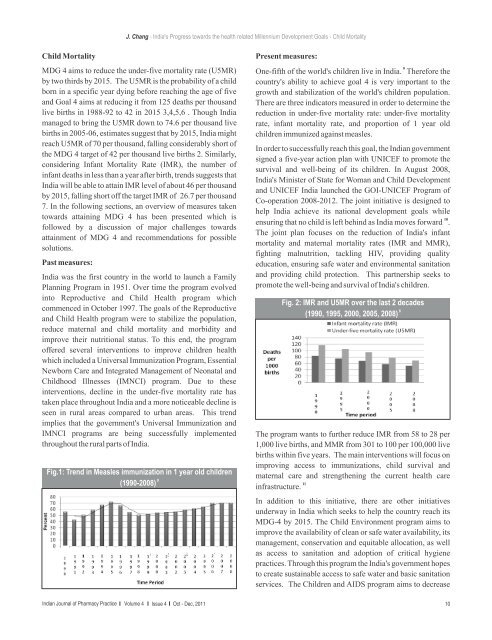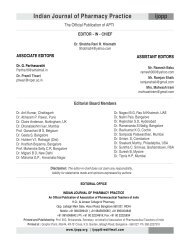J. Chang - India's Progress towards the health related Millennium Development Goals - Child MortalityChild MortalityMDG 4 aims to reduce the under-five mortality rate (U5MR)by two thirds by 2015. The U5MR is the probability <strong>of</strong> a childborn in a specific year dying before reaching the age <strong>of</strong> fiveand Goal 4 aims at reducing it from 125 deaths per thousandlive births in 1988-92 to 42 in 2015 3,4,5,6 . Though Indiamanaged to bring the U5MR down to 74.6 per thousand livebirths in 2005-06, estimates suggest that by 2015, India mightreach U5MR <strong>of</strong> 70 per thousand, falling considerably short <strong>of</strong>the MDG 4 target <strong>of</strong> 42 per thousand live births 2. Similarly,considering Infant Mortality Rate (IMR), the number <strong>of</strong>infant deaths in less than a year after birth, trends suggests thatIndia will be able to attain IMR level <strong>of</strong> about 46 per thousandby 2015, falling short <strong>of</strong>f the target IMR <strong>of</strong> 26.7 per thousand7. In the following sections, an overview <strong>of</strong> measures takentowards attaining MDG 4 has been presented which isfollowed by a discussion <strong>of</strong> major challenges towardsattainment <strong>of</strong> MDG 4 and recommendations for possiblesolutions.Past measures:India was the first country in the world to launch a FamilyPlanning Program in 1951. Over time the program evolvedinto Reproductive and Child Health program whichcommenced in <strong>Oct</strong>ober 1997. The goals <strong>of</strong> the Reproductiveand Child Health program were to stabilize the population,reduce maternal and child mortality and morbidity andimprove their nutritional status. To this end, the program<strong>of</strong>fered several interventions to improve children healthwhich included a Universal Immunization Program, EssentialNewborn Care and Integrated Management <strong>of</strong> Neonatal andChildhood Illnesses (IMNCI) program. Due to theseinterventions, decline in the under-five mortality rate hastaken place throughout India and a more noticeable decline isseen in rural areas compared to urban areas. This trendimplies that the government's Universal Immunization andIMNCI programs are being successfully implementedthroughout the rural parts <strong>of</strong> India.Fig.1: Trend in Measles immunization in 1 year old children8(1990-2008)Present measures:9One-fifth <strong>of</strong> the world's children live in India. Therefore thecountry's ability to achieve goal 4 is very important to thegrowth and stabilization <strong>of</strong> the world's children population.There are three indicators measured in order to determine thereduction in under-five mortality rate: under-five mortalityrate, infant mortality rate, and proportion <strong>of</strong> 1 year oldchildren immunized against measles.In order to successfully reach this goal, the <strong>Indian</strong> governmentsigned a five-year action plan with UNICEF to promote thesurvival and well-being <strong>of</strong> its children. In August 2008,India's Minister <strong>of</strong> State for Woman and Child Developmentand UNICEF India launched the GOI-UNICEF Program <strong>of</strong>Co-operation 2008-2012. The joint initiative is designed tohelp India achieve its national development goals while10ensuring that no child is left behind as India moves forward .The joint plan focuses on the reduction <strong>of</strong> India's infantmortality and maternal mortality rates (IMR and MMR),fighting malnutrition, tackling HIV, providing qualityeducation, ensuring safe water and environmental sanitationand providing child protection. This partnership seeks topromote the well-being and survival <strong>of</strong> India's children.Fig. 2: IMR and U5MR over the last 2 decades8(1990, 1995, 2000, 2005, 2008)The program wants to further reduce IMR from 58 to 28 per1,000 live births, and MMR from 301 to 100 per 100,000 livebirths within five years. The main interventions will focus onimproving access to immunizations, child survival andmaternal care and strengthening the current health care11infrastructure.In addition to this initiative, there are other initiativesunderway in India which seeks to help the country reach itsMDG-4 by 2015. The Child Environment program aims toimprove the availability <strong>of</strong> clean or safe water availability, itsmanagement, conservation and equitable allocation, as wellas access to sanitation and adoption <strong>of</strong> critical hygienepractices. Through this program the India's government hopesto create sustainable access to safe water and basic sanitationservices. The Children and AIDS program aims to decrease<strong>Indian</strong> <strong>Journal</strong> <strong>of</strong> <strong>Pharmacy</strong> <strong>Practice</strong> Volume 4 Issue 4 <strong>Oct</strong> - <strong>Dec</strong>, <strong>2011</strong> 10
J. Chang - India's Progress towards the health related Millennium Development Goals - Child Mortalitythe rate <strong>of</strong> new infections and mitigate the impact <strong>of</strong> HIV andAIDS among children 0-18 years old. This program providesa comprehensive package <strong>of</strong> services to prevent mother-tochildtransmission <strong>of</strong> HIV to most HIV-positive pregnantwomen, appropriate care and treatment to HIV-positiveinfants. Additionally, the Social Policy, Planning, Monitoringand Evaluation program is working to improve data collectionand analysis systems in order to disseminate information tosupport evidence-based program planning and advocacy.Furthermore, the Advocacy and Partnerships program isbuilding a voice for children through parliament, civil societyorganizations, media, celebrities and sports endorsements12,13and campaigns to ensure children's rights.Another program implemented in India is the ChildDevelopment and Nutrition program which focus onimproving the nutritional status <strong>of</strong> the mother and child, bypromoting breastfeeding, appropriate complementary foodsand feeding practices, micronutrient nutrition the control <strong>of</strong>anemia and the care <strong>of</strong> children with severe malnutrition.Anticipated results include the reduction in the level <strong>of</strong>malnutrition, significant reduction in micronutrientdeficiencies and prevention <strong>of</strong> malnutrition in children belowthree years. Malnutrition accounts for nearly 50% <strong>of</strong> childdeaths in India. Effective measures such as exclusivebreastfeeding for the first six months <strong>of</strong> life can significantly14decrease the IMR for India .Fig. 3: Prevalence and severity <strong>of</strong> underweight children in8India (1993, 1999, 2005)Donor role:More support is needed to scale up the country's responses tothe preventable burden <strong>of</strong> child mortality. Bilateralarrangements between nations have enormous power togalvanize policy and action. These partnerships should notdepend on money alone and can be sustained by mutual trustand respect between nation-states. Multilateral institutions,meanwhile, set norms and standards, support developmentand humanitarian efforts, and act as neutral evaluators <strong>of</strong> datacollection and presentation. They act as a moral compassagainst which national policies can be measured. Academiaalso has a part to play—and a neglected part at that—inensuring the independent validity and robustness <strong>of</strong> countrydata. As experts sitting outside formal intergovernmentalnetworks, scientists have autonomy <strong>of</strong> analysis andinterpretation that enables them to create and implement aproper accountability mechanism for policymakers 15,16.The collective work <strong>of</strong> multilateral agencies, individualnation-states, and transnational expert alliances will beessential in creating the conditions for a decade <strong>of</strong> globalaction on child health.Major Challenges and Recommendations:Targeted interventions: The lack <strong>of</strong> progress towardsattainment <strong>of</strong> MDG 4 may be contributed to various factorsbut most clearly visible among them are the U5MR disparitiesacross states, urban/rural populations, maternal education,wealth, religion, caste, and tribe 2, 17. Though some smallerstates in India have showed remarkable progress, most <strong>of</strong> thebig states are far behind. For example, the U5MR for state <strong>of</strong>Kerala is 14 deaths per thousand live births whereas for largerstates like Madhya Pradesh and Uttar Pradesh, the U5MR is92 and 91 per thousand live births respectively. The U5MRamong the poorest (101/thousand live births) is around threetimes than the U5MR among the richest (34/thousand livebirths), the U5MR among schedule caste and schedule tribepopulations is the lowest among all caste/tribe basedcategories, and U5MR for children born to uneducatedmothers (95/thousand live births) is more than three timesthan U5MR for children born to highly educated mothers withmore than 12 years <strong>of</strong> education (30/thousand live births).These indicate towards various geographical andsocioeconomic factors creating a divide among <strong>Indian</strong>population where one section <strong>of</strong> population is already wellahead <strong>of</strong> the U5MR goals set for 2015, whereas the othersection is abysmally behind 17. One <strong>of</strong> the keyrecommendations in such situations would be to prioritize theefforts and interventions by targeting populations with thehighest U5MR rates.Modify strategies to address neonatal conditions: Some <strong>of</strong> themajor factors responsible for child deaths are pneumonia,measles, diarrhoea, malaria, and neonatal conditions 17.Under five and infant mortality due to pneumonia, measles,diarrhea and malaria have been reduced through interventionssuch as immunization and oral dehydration therapy whichhave helped in saving the lives <strong>of</strong> millions <strong>of</strong> children 18 .However, a lot more can be done to address child mortalitydue to neonatal conditions. According to a study byHouweling et al. (2010) 19, 21% <strong>of</strong> under five deaths in theworld occur in India out <strong>of</strong> which, 54% are due to neonatalconditions. Neonatal mortality requires a different set <strong>of</strong>interventions that address the intra-partum period and<strong>Indian</strong> <strong>Journal</strong> <strong>of</strong> <strong>Pharmacy</strong> <strong>Practice</strong> Volume 4 Issue 4 <strong>Oct</strong> - <strong>Dec</strong>, <strong>2011</strong> 11
















